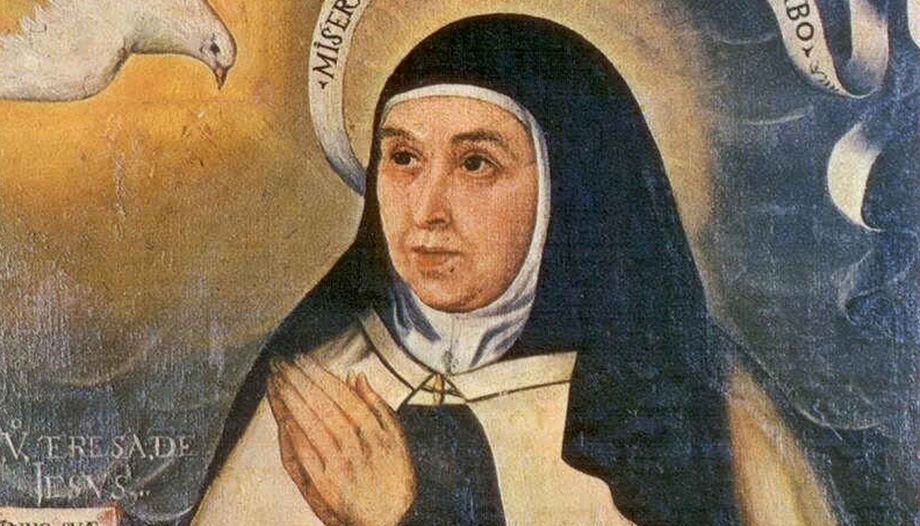




















Teresa de Cepeda y Ahumada was born in Avila in 1515, in a large and pious family. The historical context of her childhood is epic: the Reconquest has just ended, there is war in Flanders, expeditions to America, literature of chivalry. Teresa is impregnated with this magnanimity, and plays at being a hermit, a martyr to the Moors, or a lady courted in great love affairs.
Orphaned at the age of 13, she asked Our Lady to adopt her, even though she was still a child. "very much an enemy of being a nun". But the Augustinian boarding school where he was educated would gradually weaken his worldliness and lead to the appearance of a religious vocation, which resulted in his entry into La Encarnación in 1535.
Shortly afterwards, she became seriously ill. She will recover, and this weakness will remain as a constant reminder of the ephemerality of the world and the absolute need for God. In spite of this, years of spiritual lukewarmness will pass, within a tremendously relaxed religious environment.
Teresa's "conversion
In Lent 1554, with 19 years of religious life behind her, Teresa discovered a wounded Christ and received a strong gift of tears before the love of God, which changed her life.
His relationship with God is revolutionized: "A feeling of God's presence came upon me at all hours, and I could in no way doubt that he was within me, or that I was all wrapped up in him". He receives many visions and mystical experiences that push his tension towards holiness.
In addition, the desire to renew religious life, which he perceived as too comfortable, was born, an intuition that matured over the years and led to the foundation of new Carmelites and the reform of the Barefoot Carmelites.
Amidst many hostilities, he created the first Carmel of St. Joseph in Avila itself in 1562. She associated St. John of the Cross and many other saints and spiritual masters to the new Order as a true mother.
His works
His experience is the source of all his spiritual teaching, which is not little. His human warmth and his wit oblige anyone interested in his lessons to approach his spiritual notes, his poems, a very abundant collection of letters that demonstrates the network of friendships he was able to weave. And, of course, there is a major triptych of works that mark the history of Christian spirituality and Hispanic culture.
Chronologically, the first is The book of lifeas we have known it since its first edition in 1562, or The book of mercies, as Teresa herself called it. Written at the request of her confessor, it is a classic in its own right, where she proposes for the first time her personal theology of prayer. The Saint is fascinating on this point: her own life becomes a theology of the mystery of God and of Christian existence, for the benefit of all. Here she presents prayer as an experience of friendship with God, as the central Christian experience. Paraphrasing Vatican II, we could say that he discovers the universal vocation of all Christians to prayer.
Next comes Road to perfectionThe book was published in 1566, dedicated to the first group of nuns of the new Carmel of Avila. We are before a propaedeutic manual to the spiritual life in all its dimensions, from the ascetic to the mystic. Numerous interesting elements appear here: the spiritual value of fraternity and relationships, of humility and poverty, the progress of prayer, and the missionary scope of the prayer of believers.
Finally, Teresa's masterpiece is Inner castle, o The purple onesas it is commonly known. Written in 1577, it is a masterly deepening of the spiritual path of the believer, starting from the symbol of the castle and a structure of progressively interior rooms leading to the throne room. "in the depths of the soul" where dwells the King, the Bridegroom, Jesus Christ.
Throughout these spiritual halls, life in the Spirit evolves: first, passing through more ascetic phases until the mystical phases of spiritual stillness.
In the last Moradas, holiness is outlined: spiritual marriage, mystical union with God in mutual self-giving. Bernini, in his Ecstasy Roman, left us a priceless interpretation of this experience of passion and docility to an unknown Love.
Returning from the foundation of Burgos, she stopped in Alba de Tormes. Ill, literally exhausted by a life of dedication, she died in 1582. "In the end, I die as a daughter of the Church." she says relieved after a mission that has been very much contradicted, especially by her own family. "It is high time, my Husband, that we met."She warns that the perfection of the Christian life, which is love, is also fulfilled for her.
Professor of Theology at the University San Dámaso. Director of the Ecumenical Center of Madrid and Vice-consiliary of the Cursillos of Christianity Movement in Spain.












